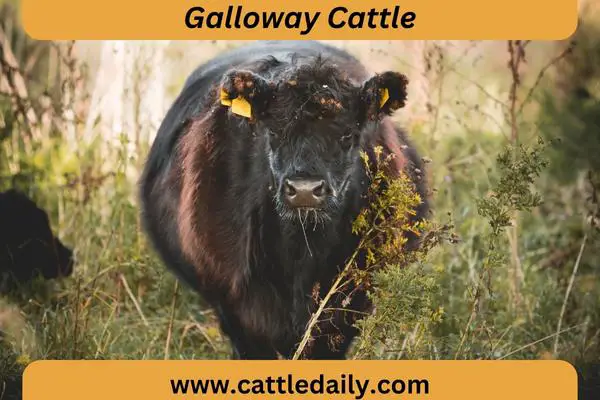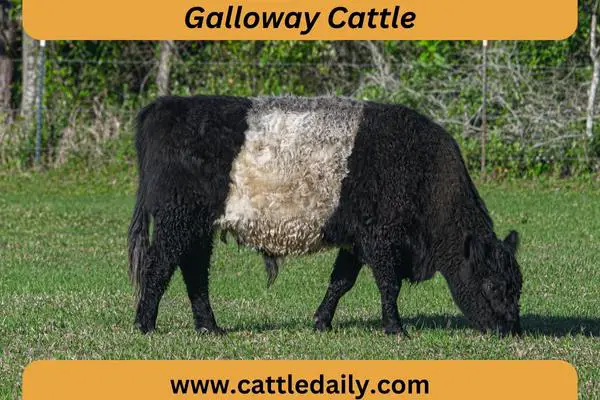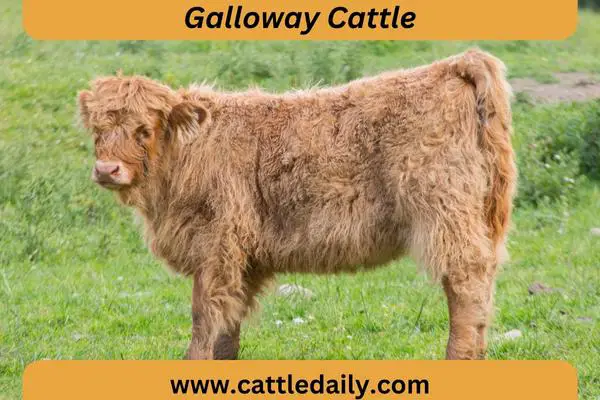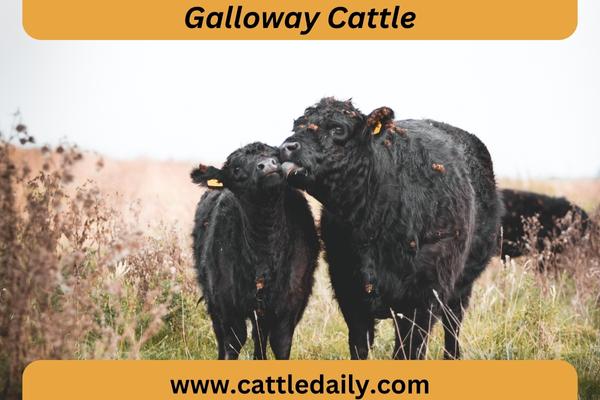Galloway Cattle
Galloway cattle are a heritage beef breed known for their hardy nature, docile temperament, and tasty meat. Originating from the Galloway region of Scotland, they are one of the oldest breeds of cattle in the world.
Galloway cattle are medium-sized, polled (naturally hornless), dual-purpose cattle. They come in three color variations – black, red, and dun (tan with black points).
Some key characteristics of this breed:
- Adaptability – Galloways are extremely hardy and can adapt to varied environmental conditions. Their coat consists of a soft, double layer of hair which allows them to thrive in cold climates.
- Calving Ease – Galloway cows are known for unassisted calvings and being great mothers. They have a high calving percentage with few birthing problems.
- Docility – This breed has a gentle, calm temperament. They are easy to handle and work with.
- Grazing Ability – Galloways are excellent foragers and efficient grazers requiring less feed intake. They can utilize poor-quality roughage.
- Marbled Beef – Their meat is finely marbled resulting in great taste and tenderness.
- Smaller Stature – Galloway cattle have a medium-sized frame making them more feed efficient. Their smaller size allows them to finish quicker.
Overall, Galloway cattle offer good maternal traits, calving ease, docility, grazing ability, and highly desirable beef qualities, making them a good choice for many cattle producers.

Origin and History of Galloway Cattle
Galloway cattle originated from the southwestern parts of Scotland in the former Galloway province, where they adapted to the rugged terrain and harsh climate.
They are one of the oldest beef breeds in the world, with written records dating back to the 1600s. However, the breed is believed to have existed since the 12th century.
Hardy Galloway cows were traditionally used for milk and beef production in Scotland before becoming primarily a beef breed in the 1800s.
Galloways were first imported to North America in 1853. The American Galloway Breeders Association was formed in 1882.
Over the years, they gained popularity across North America for their maternal abilities, carcass traits, grazing efficiency, and survival in harsh environments.
Today, they are considered a heritage breed of global importance found in many countries worldwide.
Characteristics and Temperament of Galloway Cattle
Coat and Appearance
Galloway cattle have a distinctive long, shaggy, double coat of hair. Their outer coat is wiry and coarse while the undercoat is soft and wooly. This double coat allows Galloways to thrive in cold weather and provides protection from rain and snow.
They come in three color variations:
- Black – This is the most common color seen in Galloway cattle.
- Dun – Dun Galloways have a tan or red-brown coat with black muzzles, ears, feet, and legs.
- Red – Red Galloways have a rich red coat ranging from dark red to light red.
All Galloway cattle are polled (naturally hornless) with no horns or scurs. They have broad foreheads and short, broad ears covered with hair. Their hides are thick.
Mature cows weigh from 800 to 1,200 pounds while bulls range from 1,500 to 2,200 pounds. They have a medium-sized frame and muscular build.
Docile Temperament
Galloway cattle are renowned for their docile, quiet temperament. They are extremely calm and easy to handle. Their gentle nature also makes them excellent mothers.
This docility and maternal instinct allows Galloway cows to calve unassisted in the pasture. They are very protective of their young. Galloway bulls are not aggressive and safe to work with.
The mellow disposition of Galloways makes them ideal for grazing in herds and working cattle on smaller farms. They integrate well with other livestock like sheep.

Adaptability and Hardiness
A hallmark of Galloway cattle is their adaptability to varied environments and hardiness. They are considered one of the best breeds for extensive grazing.
Some key aspects of their environmental adaptability:
- Winter Hardy – Galloways thrive in cold northern climates thanks to their double coat of hair. Their long, thick hair protects them from snow, rain, and wind.
- Heat Tolerance – Their coat also provides insulation from the sun and heat. Galloways adapt remarkably well to hot southern regions compared to other heritage breeds.
- Rugged Terrain – This breed is well-suited to marginal lands with poor forage. They handle rugged settings from woodlands to marshes.
- Disease Resistance – Galloways have strong disease resistance and health traits compared to other breeds.
- Calving Ability – Galloway cows can birth calves alone in pastures without assistance even in harsh weather.
Overall, the robustness, vigor, and adaptability of Galloway cattle allow them to thrive on marginal lands with minimal inputs.
Nutrition and Grazing Ability
Galloway cattle are known for their excellent grazing abilities. They make efficient use of grass and other roughage.
Some key facts about Galloway cattle nutrition:
- Require 30-50% less feed intake than other breeds.
- Utilize poor-quality roughage and marginal pasturelands more efficiently.
- Excellent grazers and browsers were able to harvest their own feed.
- Gain well on grass without the need for much grain supplementation.
- Wean heavier calves due to the milking ability of cows.
- Greater rumen capacity compared to size allows them to digest fibrous feeds better.
These nutritive traits mean Galloway cattle have lower input costs being able to thrive on marginal pastures without much supplementary feeding. Their grazing efficiency makes them profitable for beef production.

Maternal Traits and Calving
Galloway cows are exceptional mothers known for easy calving without assistance. They have strong maternal instincts and impart hybrid vigor to their calves when crossed with other breeds.
Key maternal traits and calving ability:
- High calving percentage with few birthing problems.
- Protective and attentive mothers. Galloway cows defend calves from predators.
- Excellent milking ability for heavier weaning weights.
- An unassisted calving rate of over 90% is common in the breed.
- Calves are small at birth weighing 60-70 lbs but grow rapidly.
- Calf mortality rates below 2% under extensive pasture conditions.
- Can produce a calf annually for over 15 years.
These maternal characteristics make Galloway cows highly fertile, long-lived, and productive even in harsh environments.
Carcass Traits and Meat
Galloway beef is known for its finely marbled texture and tasty flavor. Their meat quality makes them ideal as a terminal sire breed crossed on cows of other breeds.
Key carcass characteristics:
- Heavily marbled meat with fat dispersed through the muscles.
- Greater percentages of intramuscular fat resulting in more tender beef.
- Higher percentages of boneless closely trimmed retail cuts.
- Carcasses yield well above average – around 64-65%.
- Meat has excellent beefy flavor enhanced by marbling.
Due to their marbling and meat quality, Galloway cattle produce tender, juicy steaks and roasts that are regarded for their superior flavor. They are a profitable terminal cross.
Uses and Crossbreeding
Today Galloway cattle are mainly used as a terminal sire breed for crossing on cows of other breeds to produce premium quality feeder calves that are hardy and fast growing.
Some common crosses include:
- Galloway x Angus – Fast-growing calves with hybrid vigor and high marbling. The most popular Galloway cross.
- Galloway x Hereford – Docile and hardy calves with excellent grazing ability.
- Galloway x Holstein – Adds efficiencies and beef qualities to the dairy breed.
- Galloway x Longhorn – Carcass enhancement and maternal traits combined.
Galloway bulls impart hybrid vigor, easy calving, vigor, and carcass qualities when crossed on cows of other breeds.
In addition to crossing, Galloways are also used in:
- Heritage and Niche Markets – Prized for their heritage status and flavor.
- Grass-Fed and Organic Beef – Their extensive grazing suits these specialized markets.
- Conservation Grazing – Used for grazing wildlife areas and marginal lands.
Their docility, maternal abilities, and carcass traits make Galloway cattle a popular choice among grass-fed beef producers.
Conclusion
Galloway cattle offer many favorable traits for beef production including documentary, calving ease, grazing efficiency, mothering ability, and premium beef qualities.
This heritage breed thrives in diverse environments from cold climates to warmer regions. Their robustness and adaptability allow them to excel as a low-maintenance breed.
Galloway cattle produce tasty and tender beef with excellent marbling. Their strengths make them ideal as a terminal cross for producing fast-growing calves with hybrid vigor.
For homesteaders or pasture-based producers seeking a hardy, maternal breed that yields well-marbled beef, the Galloway is an excellent cattle breed choice. Their versatility and profitability continue to increase the popularity of Galloway cattle globally. Check and Learn here more about cattle breeds and types.

